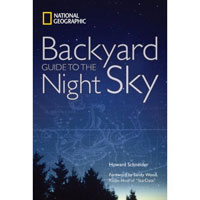 I have mentioned stargazing several times, as a great family camping activity that is interesting for adults and kids. Luckily, for those of us who are not exactly experts when it comes to astronomy, National Geographic released a new book this month that helps you find all kinds of interesting constellations and deep-space objects in the sky. The Backyard Guide to the Night Sky, written by veteran reporter Howard Schneider, walks you through everything you need to know about getting started in astronomy, from choosing the right kind of binoculars to the green flashes and zodiacal light that you can look for as the sun sets on the horizon.
I have mentioned stargazing several times, as a great family camping activity that is interesting for adults and kids. Luckily, for those of us who are not exactly experts when it comes to astronomy, National Geographic released a new book this month that helps you find all kinds of interesting constellations and deep-space objects in the sky. The Backyard Guide to the Night Sky, written by veteran reporter Howard Schneider, walks you through everything you need to know about getting started in astronomy, from choosing the right kind of binoculars to the green flashes and zodiacal light that you can look for as the sun sets on the horizon.
The book is heavily illustrated, with a number of star charts and diagrams that orient you to the night sky and help you find interesting objects. My favorite chapter is “Five Coolest Things in the Sky†which talks about Polaris and The Big Dipper, Venus, the Perseid Meteor Shower, The Pleiades, and the Andromeda Galaxy. We are going to spend a lot of time in this chapter, while we get accustomed to finding objects in the sky, and particularly on the Perseids, which peak on August 12.
Best viewing times is one of the great pieces of information that the Backyard Guide to the Night Sky provides for objects, like planets and constellations. This is very helpful when planning a camping trip, because you can pick a number of objects to find, based on the time of year. It’s also very helpful about telling you what you can expect to see, with different types of equipment.
Mars can be seen with the naked eye, but its apparent size and brightness vary markedly during its 687-day orbit. Binoculars will show its reddish color, but a telescope of modest size – a 5-inch refractor or 8-inch reflector – will reveal the planet’s details.
This is the kind of real-world information that the book provides, which makes planning family camping activities easier. That Mars is called the “red planet” didn’t make any sense to our children until they saw it through a set of binoculars. It’s this kind of discovery that makes astronomy an interesting activity for kids and adults, and there is no better place to practice it than in the backcountry.
The Backyard Guide to the Night Sky is available directly from National Geographic, or your favorite book retailer.
See also…

The book is somewhat generic in the “how-to†sections, but the star charts only cover the northern hemisphere.
Hi Melynda – that’s a great post, I think the Night Sky Star Wheel will be a great companion to the book!
Looks like a great book; we might have to add it to our library. National Geographic can usually be trusted to put out great materials.
I love stargazing and now that I live in Montana I have plenty of darkness to enjoy the night sky. We are more fall/winter/spring stargazers in our family since it gets dark so late in the summer.
I added a link to your post to my post on stargazing. http://www.yourwildchild.com/blog1.php/2009/06/15/nocturnal-activities-stargazing
Thanks, John – we’re going to give it a try and see if we can spot any.
I have vivid memories of camping as a kid, sleeping under the summer stars, and seeing many, many meteors.
The Perseids do peak on August 12th, but there are several other showers going on now and into late August. Go out any dark night for the next few weeks and you’ll see at least a half-dozen meteors per hour.